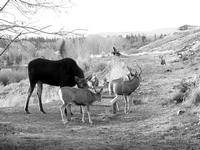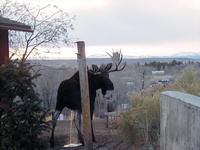|
The Sublette County Journal Volume 4, Number 14 - 12/2/99 brought to you online by Pinedale Online
Feeding wildlife in town continues to ignite the passion of people on both sides of the issue by Jennifer Binning As the weather continues to grow colder in anticipation of the earnest arrival of winter, the local deer herds begin to move down into the valley and the shelter of town. The Pinedale deer have captured the hearts of several townspeople, who are more than happy to spend some money on grain to feed the deer and moose during the winter. In return, the animals bring a beauty and wildness to the feeder's own backyards. In addition, the people feel they are helping these wild animals survive the long, harsh Wyoming winters. However, there's another side to this issue, and many Pinedale residents strongly oppose feeding wildlife in town. Indeed, there are two very strong and very opposite opinions on the matter: the feeders vs. the non-feeders. The Feeders By and large, we have found the people who choose to feed the deer and moose in town do so because they enjoy watching the wildlife, and they hate to see the condition of the less healthy animals deteriorate during a harsh winter. These animals become a part of their extended family and often they are named, with several generations returning to the feed site each winter. Art Sruoginis and his wife, who live on the side of Orcutt Hill, have adopted several moose and deer during their 9-year tenure of feeding the wildlife. They have named the Bull Moose "Bully" and the cow is one they have watched grow up from a calf.
Mr. Sruoginis admits to getting plenty of complaints about the fact that so many animals are concentrated in a small area, but he says about half of his neighbors don't mind a bit. Those Opposed to Feeding One group of neighbors who did minded was the Pinedale Cemetery Board. Just this year they erected a six-foot fence all the way around the cemetery specifically to keep the wildlife out. Cemetery Board member Julie Early said that in the past, as many as sixty deer and perhaps a dozen moose could be seen bedding down in the cemetery each evening. The animals caused thousands of dollars of damage to the landscaping and the gravemarkers as well. In addition to trampling the grass, the deer and moose would leave copious amounts of droppings on the cemetery grounds, which would have to be raked up every day and removed. Frequently, the droppings were quite loose and very difficult and messy to remove. The new fence has all but eliminated the problem, and Ms. Early feels that with the loss of this area to bed down in, the deer may disperse. Earlier this year, the Game and Fish Department removed four moose from the area near the cemetery, which had been frequent visitors to the Sruoginis feed trough. Mr. Sruoginis misses his old friends, and dismisses the notion they had become a nuisance. "How can you say they are aggressive?" he asks, walking within feet of "Bully" before the animal became spooked by the presence of a stranger - me. The Game and Fish and Ms. Early had become quite concerned about the moose on Lake Street, just below the Sruoginis house, as many children walk to school on that road, and the elementary school is quite nearby. Several children have been frightened by the moose, and frequently the animals would wander over to the Sublette Center where the staff worried about some of the residents who would walk around the block on a daily basis. Unfortunately, said Ms. Early, when you feed the wildlife it creates a higher than normal concentration of animals, and the probably of a bad result from a moose-human or moose-car encounter is greatly increased. With the risk to the children being so high, the two-cow/calf pairs were removed to the Game & Fish Sybille Wildlife Research Unit, and Ms. Early has had no further complaints about the moose in the area. The Sruoginis are not the only people in Pinedale who feed the wildlife, and the neighbors of these people are not too fond of the practice either. Many gardeners have had to resort to using netting and wire fencing to keep their yards looking beautiful in the summer and the winter, as a moose can easily strip a young tree of all leaves, limbs and bark in a matter of seconds. Several local Garden of Beauty award winners have had to build fences similar to the one at the cemetery in order to keep the flower petals on the stalks where they belong. One longtime Pinedale resident Ione McReynolds notes that when they first moved to town many years ago, there was not a problem with the deer eating her flowers, because they stayed mainly near Pine Creek, and no one enticed the animals into town with food. Pinedale Game Warden Duke Early is concerned about citizens feeding the deer and moose for other reasons. All too often, people who feed do not use a type of grain that the animals can digest. This causes the deer to fill their stomachs with grain that passes right through them as diarrhea, or causes the animal to starve because the food cannot be broken down in the gut and utilized, yet the animal feels full and will not eat anything else. This has caused several deer in the last few years to die of starvation. Necropsies on these animals revealed that their rumen, or gut, was filled with a grain they simply could not digest, and not a single animal had any fat reserves whatsoever. This is what Mr. Early calls an 'M & M' diet. "It tastes good, but it is not good for you," he says " it keeps them from eating the things they really should be eating." Supplemental feeding also causes a higher than normal concentration of animals, which increases the probability that a sick animal will infect the rest of the herd quickly. Mr. Early and local veterinarian Dr. Brent Dean note that the local deer herd has been infected with Bovine Viral Diarrhea, a disease which, according to Mr. Early, is not seen in the "wild" mule deer populations because the animals usually die before they can pass on the disease. When the sick deer are fed in the winter, they infect the rest of the herd simply because they are able to survive longer than they would under natural circumstances, and the daily mingling around the feed trough provides an ideal situation to pass the illness on to other animals. This allows less hardy animals to survive longer than they would normally, which in turn degrades the process of "natural selection" because the weaker animals live to pass on their genes to another generation. High concentrations of animals in one place such as around a feed trough, also has the potential of destroying the natural flora of the area, and eroding the soil as well. The Sruoginis backyard stands as an example of this theory, as the hillside around the feeding area is barren except for the sage, and several inches of runny, unformed deer and moose scat. The easy meals also alter the natural migration patterns of the local deer herds, as alluded to by Mrs. McReynolds. Mr. Early and Dr. Dean acknowledge that the people who feed do so with only the best intentions, but all too often the animals pay the ultimate price because a homeowner who wants to feed won't take the time to research how and what they should be feeding. Essentially, most of the experts interviewed felt the best advice was this: If you are not feeding the animals now, don't start. If you are feeding, watch the animals carefully to monitor how they are digesting the feed. There is now widely available, scientifically formulated deer wafer, which is much more digestible than other non-native grains. Remember also that no matter how well you feed the animals, they will instinctively be drawn to their native forage if it is available, which means you and your neighbors will need to cover up any landscaping you wish to keep. If you are feeding and wish to stop, wean the animals off the grain over a very long period of time, so they may begin to return to their natural eating patterns slowly, and re-establish the proper intestinal bacteria that can break down the native foods into useable nutrients. What ever you do, don't stop feeding cold turkey. Although the Game and Fish would prefer that people refrain from feeding the animals, they realize that the attraction to feeding wildlife is a strong one, and they are more that willing to discuss the proper way to feed back yard wildlife so it is a positive experience for everyone involved. Photo credits: Jennifer Binning, Jennifer Binning See The Archives for past articles. Copyright © 1999 The Sublette County Journal All rights reserved. Reproduction by any means must have permission of the Publisher. The Sublette County Journal, PO Box 3010, Pinedale, WY 82941 Phone 307-367-3713 Publisher/Editor: Rob Shaul editor@scjonline.com |

